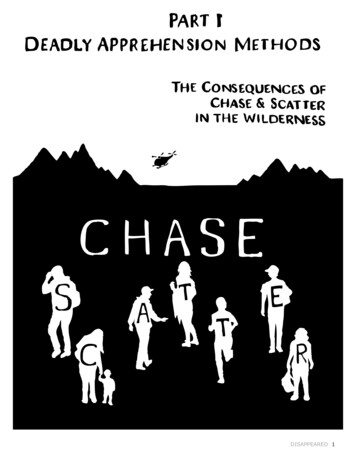
Transcription
DISAPPEARED 1
Part I: Deadly Apprehension MethodsThe Consequences of Chase & Scatter in the Wilderness“We’ll let him tire himself out, if he wants to run we’ll let him run . . . You kind of have to pick yourbattles, and I usually pick the one who runs the most . . . We’ve got bodies running all over the place . . It’s a never-ending game for us.”—Border Patrol agent in active pursuit on his all-terrain vehicle (Border Wars)1On March 6, 2015, José Cesario Aguilar Esparza was migrating on foot through Organ Pipe CactusNational Monument in Southern Arizona with his two nephews and a guide.2 The three men had spentseveral days hiding out in caves before crossing the border. They were walking at night in the highdesert mountains when Border Patrol agents began chasing after them. José Cesario’s two nephewswere arrested, but it was too dark to see what happened to the rest of the group; they rememberedhearing the sound of someone falling and a scream. José Cesario had tumbled and landed eerily on hisfeet but slumped up against rocks. He had fallen from a cliff while running: he was dead.José was identified from the ID in his wallet; his family’s contact information was in his pocket. Whenhis loved ones were informed of his death, they were told nothing of the way he had died. “We thought[Border Patrol agents] had shot him. We had no idea he had fallen from a cliff until his nephewswere able to contact us from detention, at least two weeks later,” they reported. When a No MoreDeaths volunteer contacted the US Border Patrol to confirm the details in this story, Supervising Agent1Border Wars, Season 2, episode 4, “Lost in the River.” Border Wars is National Geographic Television series that follows agents ofthe US Border Patrol and other divisions if the Department of Homeland Security while interdicting unauthorized border crossers.2Case received by La Coalición de Derechos Humanos’s Missing Migrant Crisis Line; information used with permission of José’simmediate family.2DISAPPEARED
Gutiérrez said that several agents were chasing three men, one of whom fell off a cliff.1The case of José Esparza is all too common: it demonstrates the way in which contemporaryimmigration enforcement in the US–Mexico borderlands routinely relies on the apprehension methodsof chase and scatter, which directly cause disappearance and death. Since the mid-1990s, the BorderPatrol’s policy of Prevention Through Deterrence has pushed migration into increasingly remotecorridors. In turn, Border Patrol agents have been tasked with apprehending migrants, refugees, andother border crossers in the isolated, vast expanses of wilderness between official ports of entry.2 Withthe exception of those border crossers who have already decided to surrender to border agents, thesole method of apprehension available to Border Patrol personnel is chase through deadly terrain.Part I of this three-part report investigates the US Border Patrol’s deadly apprehension methods inwilderness areas. Chase and Scatter is divided into two sections.In the first section, we discuss two major aspects of the apprehension method of chase.Environmental Hazards: Environmental hazards during pursuit often lead to injury and death.Border Patrol agents chase border crossers through the remote terrain and utilize the landscapeas a weapon to slow down, injure, and apprehend them. We show how chases lead to heatexhaustion and dehydration, blisters and sprains, injuries due to falls, and drownings.Assaults by Border Patrol: Border Patrol violence as another outcome of chase. Border Patrolagents regularly assault border crossers at the culmination of a chase. Assault then contributesto a violent cycle in which border crossers flee from both interdiction and potential seriousinjury and death and agents, in turn, often respond with escalating aggression. We examinehow chase in remote areas commonly results in excessive use of force. In our survey, tackles,beatings, Tasers, dog attacks, and assault with vehicles were all reportedly employed by theBorder Patrol against border crossers during chase.In the second section, we examine the deadly and traumatic outcomes of scatter.The scattering of border crossers causes spatial disorientation, separation from one’s guide andcompanions, loss of supplies and belongings, and exposure to the hazards of hostile terrain. In theremote wilderness, this directly leads to death and disappearance.Through analysis of surveys of border crossers and stories from the Derechos Humanos Missing MigrantCrisis Line’s database,3 our team finds that the Border Patrol’s practice of chasing and scattering bordercrossers is indisputably responsible for human deaths and disappearances. Despite the clear and mortal1No More Deaths obtained Pima County Sheriff ’s records of the incident in which investigators describe video footage from a Border Patrol aircraft that was present at the time of the fall. That footage confirms that the man fell while being pursued by both Border Patrolaircraft and agents on the ground, and that two other individuals nearly fell as well.2For the remainder of this report we will use the term border crossers to refer to all the categories of people who attempt to crossthe US–Mexico border, categories which can be distinct or overlapping. See “A Note on Language” in the introduction to this report.For this report, we follow the definition of wilderness used in wilderness medicine, namely, any location that is at least one hour oftravel time away from definitive care. For those traveling on foot through rugged terrain (while potentially medically compromised), wilderness would be between one and four miles from active roads or inhabited dwellings.Ports of entry are staffed and patrolled by the Office of Field Operations, which oversees approximately 22,000 officers. The Officeof Border Patrol oversees approximately 21,000 agents who are tasked with patrolling the areas of the border between ports of entry.3This database consists of information from the phone calls that are received. See “Data Sources,” below.DISAPPEARED 3
danger associated with these apprehension tactics, chase remains a primary apprehension method ofthe US Border Patrol.“They let them come across and chase them until they drop. That’s what kills a lot of people. It is not apleasant thing to find a corpse up there while you’re ranching cattle.”—Gary Thrasher, cattle rancher in Southern Arizona 11Paul Lewis, “Arizona’s High Desert: Where Border Politics Become a Harsh, Almost Sinister Experience,” The Guardian, October7, 2014, migration.4DISAPPEARED
Data SourcesFor this report, we attempted to locate the Border Patrol’s official policy and rules of conduct foragents in pursuit. However, no such information is publicly available. Our team then filed a Freedomof Information Act request to obtain those records, but the agency has failed to respond within thestatutorily required time frame and has yet to produce the requested records.Dangerous Enforcement Practices SurveyTo document Border Patrol apprehension methods and the impacts on those who survive theirencounters with the Border Patrol, we conducted a voluntary survey of 58 people who had attemptedto cross the US–Mexico border within the last five years. Surveys were administered in the borderregion, both in the Arizona backcountry and in Nogales, Sonora, Mexico. All information included in thisreport is shared with the express consent of participants; all names have been changed.Missing Persons Cases received by the Missing Migrant Crisis Line: cases of individuals who wentmissing in remote wilderness areasTo account for the experiences of those who died or were disappeared after they were chased and/or scattered by the Border Patrol, we examined missing persons cases reported to the Missing MigrantCrisis Line. For the purpose of Part I of this report, we only addressed the cases for the year 2015that were categorized as “closed” or “disappeared.” We did not analyze the 268 “open” cases, whoseoutcome was yet to be determined at the time of this report’s writing. Closed cases are those where the whereabouts of the individual have been discovered, which canmean anything from the individual being found in detention to recovered remains being positivelyidentified.Disappeared cases are those in which the Crisis Line team has exhausted every possible step tolocate the person without success, and has forwarded the relevant case information to otherorganizations for identification purposes should the person’s remains be found.Out of the 812 cases in the closed and disappeared categories, the report focuses on those caseswhere someone went missing while crossing through the wilderness. We excluded cases where (1)the person went missing within the detention system, (2) had crossed at an urban port of entry, or (3)the reporting party had such scarce information that it was impossible to say where or how a crossingattempt had been made. This left us with 544 cases, which we will draw from for the remainder of Part I.DISAPPEARED 5
ChaseUS Border Patrol agents approach border crossers at night, who flee, Border Wars1US Border Patrol agents are tasked with apprehending border crossers in the remote terrain betweenofficial ports of entry. After agents encounter or are alerted to the presence of suspected bordercrossers, they make an attempt to interdict and detain them. This attempt at detention often involveschase. Frequently employing helicopters, SUVs, ATVs, horses, and dogs, Border Patrol agents pursuefleeing individuals at high speeds through the wilderness.2For the purposes of this report, we define chase as the active period of pursuit of border crossers by USBorder Patrol agents during an attempted apprehension.In our Dangerous Enforcement Practices Survey, 47 of the 58 people we interviewed were chased byBorder Patrol agents within the last five years. Our team documented at least 67 incidents of chasein remote terrain, meaning that a number of individuals were subject to chase multiple times. Thesenumbers support our finding that chase is the predominant method used by the Border Patrol toapprehend border crossers.61Season 2, episode 1, “Death on the Rio Grande.”2The Border Patrol uses horses and ATVs often in roadless, isolated desert areas, where vehicles have no access point.DISAPPEARED
Injury and Death Due to Environmental HazardsA family member of Maycol, a 29-year-old man from El Salvador, contacted the Missing Migrant CrisisLine for help. Maycol had gone missing on the morning of August 27, 2015 in South Texas. A BorderPatrol helicopter had hovered low over the group he was traveling with in the early morning hours andeveryone ran into the brush. In the course of the ensuing chase, Maycol injured his foot and was leftbehind by his companions. He told his family in a text message that he thought his foot was broken.Eight months later, no information has been found as to Maycol’s whereabouts.1The high-speed pursuit of border crossers by the Border Patrol can span multiple hours as agentsattempt to corral those fleeing on foot into choke points in order to apprehend them. Chases occurin rugged areas characterized by cacti, trees, shrubs, cliffs, canyons, and rocky ground. In these areasof the Southwest border, average temperatures are extreme, reaching as high as 120 degrees in thesummer and well below freezing in the winter. Nighttime chases render border crossers blind to theunforgiving terrain, while Border Patrol agents employ night-vision equipment so that they themselvescan see and avoid deadly obstacles.“We run as if we were blind, as if we had a cloth over our eyes. Border Patrol can see everythingthough, and they know where the fences and the cliffs are.They will chase you towards them.”—Border crosser in the desert who had suffered lacerations from running into a barbed-wire fence2Long-distance chases result in frequent injuries such as foot blisters, muscular exhaustion, and sprainsand strains, as well as illnesses caused by dehydration and hyperthermia and the exacerbation ofpreexisting medical conditions. Running along winding and narrow trails, through dense trees or brush,and down steep inclines routinely results in traumatic falls. In the Dangerous Enforcement PracticesSurvey, participants reported that in 27 (40.9%) instances of pursuit by Border Patrol resulted insomeone being injured by the terrain.3 The most commonly reported injuries are to the leg and foot.41Missing Migrant Crisis Line.2Dangerous Enforcement Practices Survey.3Injured by the terrain, as opposed to injured by Border Patrol agents during chase. The latter type of injury will be mentioned inthe section “Injury and Death Due to Border Patrol Violence.”4Dangerous Enforcement Practices Survey.DISAPPEARED 7
“That’s about a mile-and-a-half straight run down rocks. I don’t know how he didn’t kill himself.”—Border Patrol agent J. J. Carrol on someone’s unsuccessful attempt to flee his presence1ExhaustionA man contacted the Missing Migrant Crisis Line in August of 2015 to reportthat his brother, Cirilio, had been crossing through the South Texas desert ina group when, according to another group member, they were pursued by ahelicopter. This group member had called to tell Cirilio’s family that Cirilio hadbeen left behind in the “middle of the desert” with symptoms consistent withheat exhaustion. The group left him with food and water. Eight months later,Cirilio has not been found.2The exhaustion and dehydration experienced by Cirilio are frequentconsequences of protracted Border Patrol chases. With water sources beingscarce or polluted, dehydration sets in quickly during chase. Groups that mighthave rested in the shade during the heat of day will choose exposure to the sun during prolongedchases by Border Patrol agents. Exhaustion contributes to further injury as border crossers becomesluggish and clumsy while traversing challenging terrain.“So we’ve been pushing this group for over three hours now and they’re still moving.”—Border Patrol agent Chris Hamer (Border Wars)3Blisters and SprainsWilma was walking with five people at night when she and her group saw flashlights and startedrunning. This was the second time they had been chased by the Border Patrol in the same crossing.They ran into a ditch and when they came out, there was one member of the group whom they couldnot locate. The missing man was 50 years old; he had been very tired with blisters on both of hisfeet. Two hours later, Border Patrol agents detained all of the people in Wilma’s group except for the50-year-old man. His name was Adolfo and he was from Puebla and had been heading to Colorado. It isunknown what happened to him.4Friction injuries such as foot blisters are a common injury of border crossing,and travel during the rainy seasons results in more extreme blistering as feetare continuously wet. Such injuries occur more often during Border Patrolchases.Severe blistering can grow to span the surface area of the bottom of both feetand can impact the ability to keep up with a group or guide, as well as theability to seek rescue. The possibility for infection is also heightened when, as often, people are withoutsupplies to treat their wounds.1Border Wars, Season 2, episode 8, “Man Hunt.”2Missing Migrant Crisis Line.3Season 2, episode 2, “Checkpoint Texas.”4Maria Jimenez, Humanitarian Crisis: Migrant Deaths at the U.S.-Mexico Border, American Civil LIberties Union, October 1, manitariancrisisreport.pdf.8DISAPPEARED
Other low-impact injuries, such as sprains and strains of the knees and ankles, occur frequently duringchase. As with blisters, these injuries can ultimately make it impossible for border crossers to continuewalking or to seek help.Injured upon Impact: FallsÁngel attempted to cross the border in February of 2016 through Arizona. While walking, Ángel waschased by a US Border Patrol helicopter, which reportedly hovered over his group and pursued themfor over an hour at very low altitudes, flying at “about the height of a telephone pole.” So close to theground, the helicopter kicked up dust around those fleeing. During the chase, Ángel’s foot went into ahole in the ground and he fell. He twisted his ankle and struck the front of his knee against a rock. Heremained where he was as the helicopter passed over and continued after the group. Ángel limpedthrough the desert for three days afterward looking for help. At the time of the survey, 10 days afterthe chase, he was still unable to walk without crutches.Many blunt-force injuries occur when border crossers trip and fall while running from agents. Thesechase-induced injuries can be fatal or disabling. As in Ángel’s case, a person who suddenly falls duringchase can be left behind by their group, alone and injured in the wilderness.“What do you think happened to him?”“I think the man died, bled out.There was too much blood.”“Do you think somebody found him?”“I don’t think so. Because Border Patrol agents only look for those who are running; they want to tryto catch those who are running. They don’t go after those who stay behind.They don’t even care.Idon’t think they found him or helped him.”—A man describing a group member who broke his lower leg while beingchased by Border Patrol agentsDISAPPEARED 9
Injured by Chase into or over BarriersMaría had been walking in a group of five when a Border Patrol vehicle approached. The group startedto run, and Border Patrol agents pursued them on foot. María fell behind andtried to climb over the border wall back into Mexico to get away. She fell fromthe wall and broke her foot and was bedridden for two months.1Injuries from impact with fences and walls occur during chase by Border Patrolagents. Our team documented incidents where border crossers had tangledthemselves in barbed-wire fences or had attempted to climb fences toppedwith razor wire or different types of border walls to flee from Border Patrolagents—all resulting in serious injury.“We’ve seen people lose fingers and whatnot.”-Border Patrol agent speaking to the camera after pulling a man off the borderwall. The man remained on the ground, bleeding from one hand and his lower leg.2DrowningsThe mother of Nestor, 26 years old, called the Missing Migrant Crisis Line looking for help. Nestor hadcrossed through Laredo, Texas in December. According to his mother, he did not know how to swimvery well. He was traveling with another person and the two had crossed the Rio Grande together.Nestor’s friend was climbing out of the river when Border Patrol agents approached them. Nestor fledalong the edge of the river—and then fell into the water. When Nestor’s companion was caught by theBorder Patrol, he reported hearing Nestor’s shouts from the river and explained that Nestor could notswim well. The agents said they would look for him. Four months later, no information has been foundas to Nestor’s whereabouts.3The Rio Grande is the most deadly stretch of water for those crossing into the United States.Demarcating the border between Texas and Mexico, the Rio Grande has strong undercurrents,whirlpools, concealed debris, quicksand, and sharp rocks.4 Release of dammed water from upstreamreservoirs can unleash a deadly wave in a matter of moments.The Rio Grande is not the only deadly waterway along the border. In California’s American Canalalone, 550 people have drowned since 1940, many while attempting to cross into the US withoutauthorization. In one 2015 case received by the Missing Migrant Crisis Line, a man was chased byBorder Patrol agents into the American Canal and was confirmed to have drowned.In the year 2015, the Missing Migrant Crisis Line received eight cases of individuals who had died ordisappeared after chase by Border Patrol agents toward a body of water. Agents’ pursuit of border101Ibid.2Season 2, episode 6, “Border Wars”3Missing Migrant Crisis Line.4Jorge Ramos, “A Dangerous Crossing,” Fusion, July 29, 2014, .DISAPPEARED
crossers back into dangerous waterways—which many were only able to cross initially with theassistance of tubes and other swimmers—clearly endangers lives and leads to deaths by drowning. 1The fire chief for Mission, Texas reported that the number of bodies recovered from their area of theRio Grande increased from one a month to one a week in the first six months of 2015. 2 Exact counts ofdrownings in the Rio Grande are not known; no binational effort to document these deaths exists.“They get tied down [by debris] and it’s hard to get away from that in black water. And they areoften panicking, running from agents.”-Capt. Joel Dominguez, part of the Mission, Texas dive-and-rescue team3Dangerous waterways are featured in Border Wars episodes that chronicle enforcement activities in theSouth Texas backcountry. In one episode, US Border Patrol agents are shown recovering the body of ayoung man found floating in the water. The agents comment that the deceased person was probablysomeone they had “spooked” back into the water. In another episode, a Border Patrol agent remarks,“I consider myself a halfway decent swimmer; I wouldn’t try to swim across that,” after a bordercrosser flees from enforcement back into the waters of the Rio Grande. In one scene, Border Patrolagents are shown chasing after a group of border crossers and taking possession of their inner tubeson the US side. Then, agents chase the group back into the river. The individuals, up to their chests inthe floodwaters, plead with the agents to return their flotation devices so they can make the trip backacross to Mexico. The agents refuse, night falls, and some members of the group appear to attemptthe return crossing. A woman screams from the middle of the river that her child is drowning. BorderPatrol agents on the shore appear uncertain about how to proceed; they give some tubes to the peoplestanding in the water, and say that those people might go rescue the child. Eventually, they decide tocall a helicopter, which later sweeps over the river.4 No one, however, is seen in the downstream watersof the channel.51It is not only the US Border Patrol that pursues people into these perilous waters. “We do not aim to detain, we would much rathersend them back into the river into Mexico,” said a Texas Militia member. David Neiwert, “Border Militiamen Detaining Migrants, SowingFear among Camp Neighbors,” Southern Poverty Law Center, October 9, 2014, ng-camp%E2%80%99s-neighbors.2Seth Robbins, “Drownings along Rio Grande Spike after Enforcement Surge,” Yahoo News, March 29, 2015, nde-spike-enforcement-surge-144558350.html?ref gs.3Seth Robbins, “Drownings along Rio Grande Spike after Enforcement Surge,” Yahoo News, March 29, 2015, nde-spike-enforcement-surge-144558350.html?ref gs.4In one incident in Border Wars there is an acknowledgment of the deadly combination that helicopters and swimmers make. Apilot remarks, “The rotor wash coming off these heavy helicopters forcing air down can literally shove them under the water and can causesomeone to have a panic response and drown.” Season 2, episode 4, “Lost in the River.”5Season 2, episode 15, “Storm Surge.”DISAPPEARED 11
Injury and Death Due to Border Patrol ViolenceThe mother of a young man from Mexico called the Missing Migrant Crisis Line to ask for help locatingher son, Ernesto. He had been arrested and she had been informed by the consulate that he had“been beaten” by US Border Patrol agents. Eventually, she made contact with her son in detentionand learned that he had been running from the Border Patrol when an agent tackled him to theground. According to Ernesto, the agent then stood up and drove his knee down onto his back. Theagent grabbed his arm and twisted it behind him. When Ernesto cried out in pain, the agent hit himrepeatedly over the head. Three months later, Ernesto was still seeking medical attention while stillbeing held in immigration detention in the US. He continued to suffer problems with his vision thatstarted after the Border Patrol assault in the desert. When he finally saw a doctor “to get glasses” totreat his vision impairment, the doctor ordered a scan of Ernesto’s brain and said that glasses were notneeded: Ernesto was suffering from brain swelling from the beating he had received from the BorderPatrol three months prior. This swelling of his brain continues to affect his vision.1As an agency, the US Border Patrol has been underincreasing scrutiny for its excessive use of force, includingduring apprehension. Much of the public reporting onuse of force by Border Patrol agents focuses on theactivities of personnel in urban areas around ports ofentry, but our research finds that it is also routine forBorder Patrol agents to use excessive force in remoteareas, especially during apprehension attempts involvingchase.2 In the Dangerous Enforcement Practices Survey,12 (18.2%) instances of chase resulted in Border Patrolinjuring someone during the apprehension attempt.Consequently, injuries abound when border crossers aredetained in the backcountry through physical force.TacklesIsmael was walking at 3 a.m. in a group when they heard engines. Border Patrol agents were soonriding up on horseback and foot. Ismael and the others began to run, and a Border Patrol agent threwhimself onto Ismael’s back. Ismael fell onto his right forearm and lacerated the skin. At the time of theinterview, six days later, he still had an open wound on his arm. 3Our Dangerous Enforcement Practices Survey shows, through testimonies like the one above, that1Missing Migrant Crisis Line.2See, for example, what an American Civil Liberties Union spokesperson terms “high-speed pursuit syndrome,” in which “officersget so angry and pumped up, and the adrenaline rush is such that again and again . . . you see violence visited on suspects at the end of apursuit.” Kevin Mullen, “The High-Speed Pursuit Syndrome,” SF Gate, March 5, 1996, hase-syndrome-3148123.php.312Dangerous Enforcement Practices Survey.DISAPPEARED
tackle is one of the primary methods of apprehending border crossers. We recorded stories of bordercrossers slammed into cacti, sharp rocks, and tree branches.“Agent Mcardle has a problem: the man may now be seriously injured and unable to stand.”-Narrator of Border Wars, after an agent tackled a seated man and sent him rolling “about 50 feet”down a hill1BeatingsIn our Dangerous Enforcement Practices Survey, our team documented three cases in which a bordercrosser was beaten during arrest in the wilderness. In the first case, a man reported that US BorderPatrol agents had beaten a member of his group with the butt of a gun. In the second incident, a bordercrosser watched a man being beaten during arrest. Afterward,, the man who received the beatingrelated that he had also been assaulted by a Border Patrol agent during his previous arrest. In the thirdincident, a woman witnessed multiple Border Patrol agents kicking a man in her group while he wason the ground. She reported that in the course of the assault, agents were cursing and laughing at thevictim. The Border Patrol agents then “threw her onto the ground,” and when she began to cry audibly,one of them said, “Pick her up, she’s a woman,” thus ending the assault.Dog AttacksThe US Border Patrol employs “K-9” dog units during chases in the backcountry to follow the tracksof border crossers. Our documentation shows that Border Patrol dogs have been set upon individualsduring apprehension.2 Our team recorded two specificincidents in which border crossers were bitten and draggeddown by Border Patrol dogs during chases in the wilderness.In another testimony, individuals reported that Border Patrolagents threatened a group of border crossers saying that theagents’ dog would maul them if they moved.Agent to a crying four-year-oldabout the dog that had just trackedand pursued him.3TasersOur survey team spoke to three people who were “tased” by Border Patrol agents or witnessed atasing while they were chased by agents. Two of these incidents occurred well after the issuance of theBorder Patrol’s new Use of Force Policy, which limits Taser use to situations where “a suspect poses animminent threat.”41Season 1, episode 3, “Dead of Night.”2In a public statement, the president of the National Association for the Protection of Human Rights in Mexico said, “We recentlyhad a case where a migrant was detained with the help of dogs, which bit the migrant on various parts of his body . . . He had to be hospitalized.” Quoted in Jesús Rivera, “Migrantes Agredidos,” La Prensa, July 17, 2013, http://www.laprensa.mx/notas.asp?id 215235.In a lawsuit filed against the Border Patrol, a man said that he had been bitten repeatedly in the arm by a Border Patrol dog andhad cried out to the agents for help but they did nothing to stop the attack. This left him with severe injuries to the muscles of his arm andwithout the ability to lift heavy objects a year afterward. “Narco Demanda a Patrulla Fronteriza por Mordedura de Perro,” El Siglo de Torreón, December 12, 2014, a-deperro.html.3Season 4, episode 2, “Meth Mobile.”4Department of Homeland Security, Use of ns/dhs-use-of-force-policy.pdf. USCustoms and Border Protection, Use of Force Policy, Guidelines, and Procedures Handbook, Office of Training and Development, May2014, https://www.cbp.gov/sites/default/fi
Gutiérrez said that several agents were chasing three men, one of whom fell off a cliff.1 The case of José Esparza is all too common: it demonstrates the way in which contemporary immigration enforcement in the US–Mexico borderlands routinely relies on the apprehension methods of chase a











